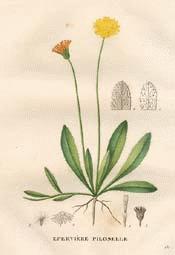
Botanical.com Home Page

|
Mouseear Hawkweed
(Hieracium Pilosella LINN.)
Click on graphic for larger image
|
Hawkweed, Mouse-Ear
Botanical: Hieracium Pilosella (LINN.)
Family: N.O. Compositae
---Synonyms---Hawkweed. Pilosella. Mouse Ear.
---Part Used---Herb.
None of the Hawkweeds are now much used in herbal treatment, though in many parts of Europe they were formerly employed as a constant medicine in diseases of the lungs, asthma and incipient consumption, but the small Mouse-ear Hawkweed, known commonly as Mouse-ear is still collected and used by herbalists for its medicinal properties. It is very common on sunny banks and walls, and in dry pastures, and is well distinguished from all other British plants of the order, by its creeping scions or runners, which are thrown out in the same manner as in the strawberry, by its small rosettes of hairy, undivided leaves, greyish green above and hoary beneath, with a dense white coat of stellately branched hairs, and by its bright lemon-coloured flowers, which are borne singly on the almost leafless stems, which are only a few inches high. The flower-heads, which are about an inch in diameter, are composed of about fifty florets, the outer having a broad, purple stripe on the under side. They open daily at 8 a.m. and close about 2 p.m. The plant is in bloom from May to September.
The Mouse-ear differs from all other milky plants of this class, in its juice being less bitter and more astringent, and on account of this astringency, it was much employed as a medicine in the Middle Ages under the name of Auricula muris, from which the popular name is taken. It has sudorific, tonic and expectorant properties, and is considered a good remedy for whooping cough (for which, indeed, it has been regarded as a specific) and all affections of the lungs.
The infusion of the whole herb is employed, made by pouring 1 pint of boiling water on 1 OZ. of the dried herb. This is well sweetened with honey and taken in wineglassful doses. A fluid extract is also prepared, the dose being 1/2 to 1 drachm. The powdered leaves prove an excellent astringent in haemorrhage, both external and internal, a strong decoction being good for haemorrhoids, and the leaves boiled in milk are a good external application for the same purpose.
- Drayton has written:
- 'To him that hath a flux, of Shepherd's Purse he gives,
- And Mouse-ear unto him whom some sharp rupture grieves.'
The name 'Mouse-ear' is also applied to 'Mouse-ear Chickweed,' a plant of the genus Cerastium, to a plant of the genus Myosotis, valued for its medicinal properties, and to various kinds of Woundworts.
- Culpepper gives many uses for Mouse-ear Hawkweed. He tells us that:
- 'The juice taken in wine, or the decoction drunk, cures the jaundice, though of long continuance, to drink thereof morning and evening, and abstain from other drink two or three hours after. It is a special remedy for the stone and the tormenting pains thereof; and griping pains in the bowels. The decoction with Succory and Centaury is very effectual in dropsy and the diseases of the spleen. It stayeth fluxes of blood at the mouth or nose, and inward bleeding also, for it is a singular wound herb for wounds both inward and outward.... There is a syrup made of the juice and sugar by the apothecaries of Italy, which is highly esteemed and given to those that have a cough, and in phthisis, and for ruptures and burstings. The green herb bruised and bound to any cut or wound doth quickly close the lips thereof, and the decoction or powder of the dried herb wonderfully stays spreading and fretting cankers in the mouth and other parts. The distilled water of the plant is applicable for the diseases aforesaid and apply tents of cloths wet therein.'
The herb is collected in May and June, when in flower and is dried.
Parkinson states that if 'Mouseare' be given to any horse it 'will cause that he shall not be hurt by the smith that shooeth him.' Also that skilful shepherds are careful not to let their flocks feed in pastures where mouseare abounds 'lest they grow sicke and leane and die quickly after.'
See:
DANDELION
HAWKBITS, AUTUMNAL
HAWKBITS, ROUGH
GOATSBEARD
[Top]
Common Name Index
A MODERN HERBAL Home Page
Bear in mind "A Modern Herbal" was written with the conventional wisdom of the early 1900's. This should be taken into account as some of the information may now be considered inaccurate, or not in accordance with modern medicine.
© Copyright Protected 1995-2025 Botanical.com
|

